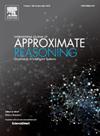Interval three-way decision model based on data envelopment analysis and prospect theory
IF 3.2
3区 计算机科学
Q2 COMPUTER SCIENCE, ARTIFICIAL INTELLIGENCE
引用次数: 0
Abstract
Since the three-way decision theory was proposed, two paradigms, “narrow sense” and “broad sense”, have gradually evolved, each demonstrating unique advantages in handling multi-granularity information and uncertainty analysis. These approaches provide a systematic theoretical framework for solving complex decision-making problems. However, the traditional three-way decision model has limitations in multi-input-output scenarios, and the current method is still insufficient in characterizing the risk attitudes and psychological characteristics of decision-makers. To address these challenges, this paper proposes an interval three-way decision model based on Data Envelopment Analysis (DEA) and Prospect theory for multi-input-output decision problems. First, we define a many-valued decision information system based on DEA, using benefit scores from various orientations as decision attributes to formulate decision strategies. Second, to mitigate the subjective bias introduced by reference points in Prospect theory, we introduce triangular fuzzy reference points that account for interval uncertainty. Additionally, we propose a calculation method for the multi-input-output interval membership function of Decision-Making Units (DMUs) and a construction method for the value function. Comprehensive decision rules are derived by calculating the overall prospect value. Finally, the effectiveness of the proposed model is validated using a series of experiments across multiple datasets, with comparisons to over ten existing methods. The results indicate that the model achieves competitive performance in terms of classification accuracy and decision-making efficiency, demonstrating its strengths in addressing uncertain multi-input-output decision problems while incorporating decision-makers' risk preferences in an interval environment.
基于数据包络分析和前景理论的区间三向决策模型
自三向决策理论提出以来,“狭义”和“广义”两种范式逐渐演化,在处理多粒度信息和不确定性分析方面各具优势。这些方法为解决复杂的决策问题提供了系统的理论框架。然而,传统的三向决策模型在多投入产出情景下存在局限性,目前的方法在刻画决策者的风险态度和心理特征方面还存在不足。针对这些问题,本文提出了一种基于数据包络分析(DEA)和前景理论的多投入产出区间三向决策模型。首先,我们定义了一个基于DEA的多值决策信息系统,利用不同方向的效益得分作为决策属性来制定决策策略。其次,为了减轻前景理论中参考点带来的主观偏差,我们引入了考虑区间不确定性的三角模糊参考点。此外,我们还提出了决策单元多投入产出区间隶属函数的计算方法和价值函数的构造方法。综合决策规则是通过计算整体远景值而得到的。最后,通过跨多个数据集的一系列实验验证了所提出模型的有效性,并与十多种现有方法进行了比较。结果表明,该模型在分类精度和决策效率方面都具有一定的竞争力,在考虑决策者在区间环境下的风险偏好的情况下,在解决不确定的多投入产出决策问题方面具有一定的优势。
本文章由计算机程序翻译,如有差异,请以英文原文为准。
求助全文
约1分钟内获得全文
求助全文
来源期刊

International Journal of Approximate Reasoning
工程技术-计算机:人工智能
CiteScore
6.90
自引率
12.80%
发文量
170
审稿时长
67 days
期刊介绍:
The International Journal of Approximate Reasoning is intended to serve as a forum for the treatment of imprecision and uncertainty in Artificial and Computational Intelligence, covering both the foundations of uncertainty theories, and the design of intelligent systems for scientific and engineering applications. It publishes high-quality research papers describing theoretical developments or innovative applications, as well as review articles on topics of general interest.
Relevant topics include, but are not limited to, probabilistic reasoning and Bayesian networks, imprecise probabilities, random sets, belief functions (Dempster-Shafer theory), possibility theory, fuzzy sets, rough sets, decision theory, non-additive measures and integrals, qualitative reasoning about uncertainty, comparative probability orderings, game-theoretic probability, default reasoning, nonstandard logics, argumentation systems, inconsistency tolerant reasoning, elicitation techniques, philosophical foundations and psychological models of uncertain reasoning.
Domains of application for uncertain reasoning systems include risk analysis and assessment, information retrieval and database design, information fusion, machine learning, data and web mining, computer vision, image and signal processing, intelligent data analysis, statistics, multi-agent systems, etc.
 求助内容:
求助内容: 应助结果提醒方式:
应助结果提醒方式:


